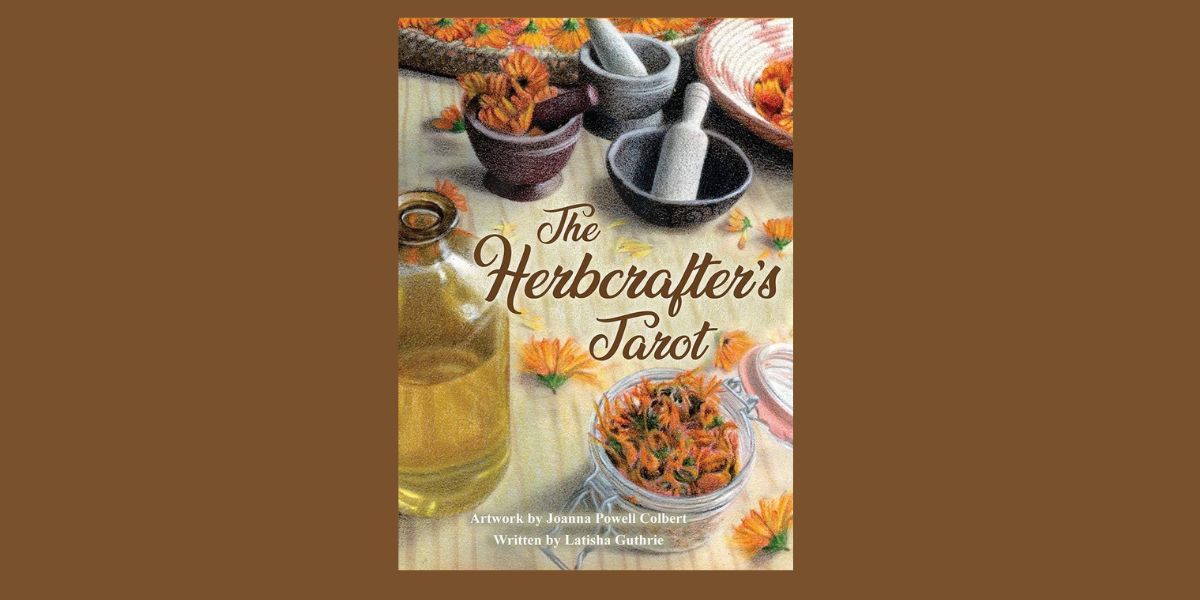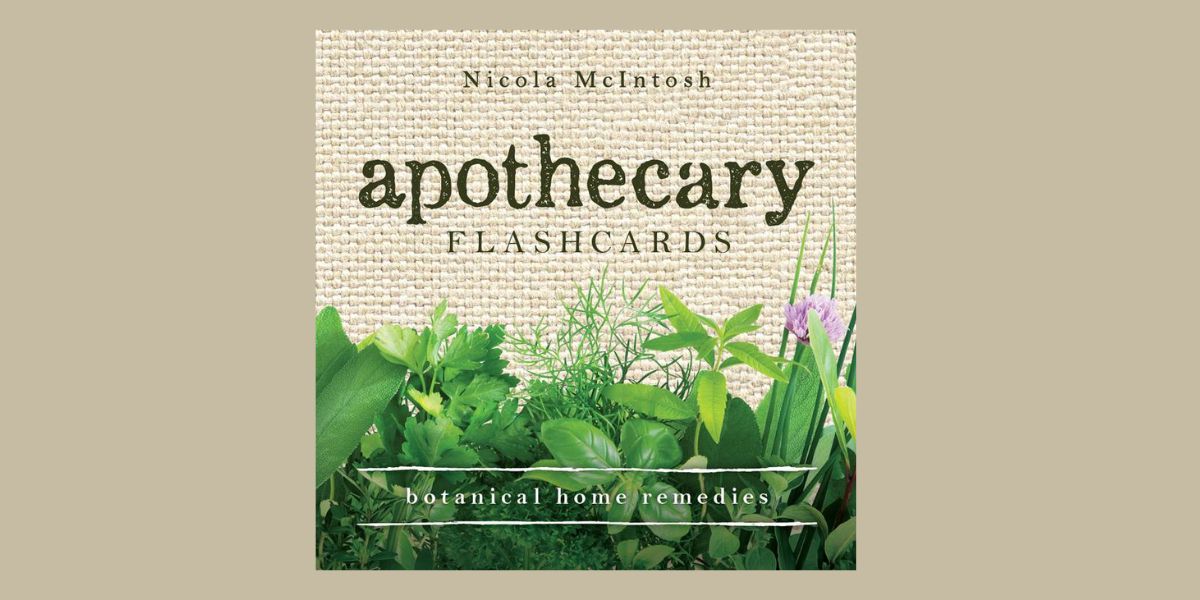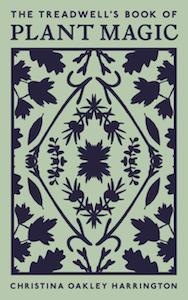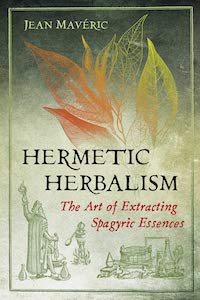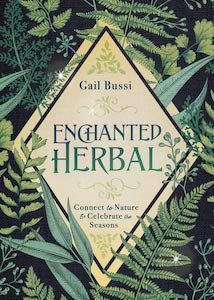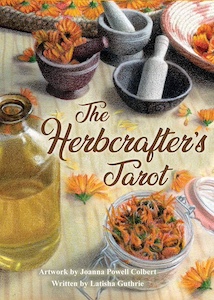
The Herbcrafter’s Tarot, by Latisha Guthrie with artwork by Joanna Powell Colbert
U.S. Games System Inc., 1572819723, 124 pages, 78 cards, May 2019
The traditional tarot images often grow stale for me. In delving into why this happens, I reached the conclusion it was because they aren’t always relatable. Symbolic? Sure. But sometimes I just want to see images from daily life; I want to see scenes of my day to day. It was my quest for this domestic, homey feeling I was seeking in my readings that led me to The Herbcrafter’s Tarot by Latisha Guthrie.
The Herbcrafter’s Tarot by Latisha Guthrie is a beautifully crafted deck that intertwines the wisdom of the natural world with the mystical art of tarot reading. This 78-card deck, created in collaboration with illustrator Joanna Powell Colbert, is a celebration of the healing power of herbs and plants. Each card is thoughtfully designed to depict a specific plant, along with its symbolic meanings and practical applications, making it a unique blend of botanical knowledge and spiritual insight. And the imagery was spot-on for what I was seeking!
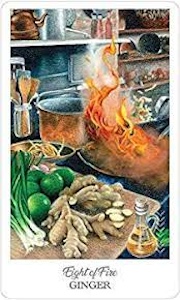
The cards are from the point of view of the reader. The Major Arcana cards depict a natural altar to the herb and its corresponding energy. They represent the gratitude the herbcrafter feels “for the gifts and insights the plants give her.”1 Some of the altars looked planned out, such as the ones in the shape of the mandala, while others are simply the altars that arise during herbcrafting as one is actively engaged in their process.
The Court Cards, which in this deck are called People Cards, all feature hands of the herbcrafter. They show hands doing all sorts of mundane tasks: picking plants, drawing a bath, pouring a tea kettle. She writes:
“Our intention is to highlight the plant as well as to celebrate the slow intentional ritual of handcrafting. With every berry gathered and tincture mixed we enflesh the sacred, making prayer visible.”2
In this deck, the Court Cards are Hijas (Daughters, traditionally Pages), Adelitas (Warriors, Traditionally Knights), Madres (Mothers, traditionally Queens), and Curanderas (Healers, traditionally Kings). Characterizing the Court Cards in this way made me feel extra connected to this deck too because these are the types of people that show up in my life; it’s easier for me to identify a motherly figure than it is a queen.
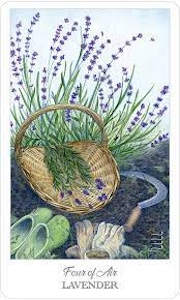
Other cards in the deck depict momentary scenes of what it looks like in the midst of gardening, having a cup of tea in bed with the moon shining above, or simply gazing at nature scenes of gardens, rivers, and trees exuding their beauty. As I browse the cards, I instantly feel at peace, grounded, and connected to the natural world. Yet the imagery takes on a whole additional layer of meaning after reading the guidebook.
Guthrie explains how instead of traditional tarot suits (swords, wands, cups, and pentacles), their corresponding elements are used for the Minor Arcana (air, fire, water, and earth). And the cards for each element have a theme: air shows the observation of nature, fire the transformation of the herbs, water focuses on baths and teas, and earth showcases “baskets and fiber arts”, which are considered “legacy tools.”3
Furthermore, the herbs were chosen for each number within the elemental Minor Arcana based on “how they contribute to an ecosystem”.4 Guthrie provides a list for numbers 1-10 to explain the roles of one. The guidebook also groups the cards by number, so rather than looking through a section on a specific element, one looks to section on that number and then finds their element within.
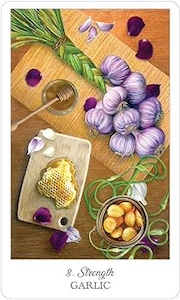
One of my favorite cards in the deck visually is Strength, which is the Garlic card. This is a Major Arcana card, so I knew it was depicting an altar of sorts, but it is certainly one of those altars that arises naturally from being in the moment. While I could describe it for you myself, a real bonus of the guidebook for this deck is that each entry features a description of the card. This is what the guidebook says about this card:
“A braided cluster of purple garlic rests on a cloth made of natural fibers. Roses from a nearby vase begin to dry, and petals have fallen on the table. Golden liquid seeps from a heart-shaped honeycomb onto a wooden board. Green scrapes fold into their lemniscate shape surrounding a pot of garlic cloves submerged in honey.”5
Guthrie perfectly captures the scene in each card with her vivid descriptions of the imagery. Even though I’m gazing at the card, her words bring the setting to life; I can feel it with my senses, further opening my intuitive understanding of the card.
The guidebook also features the Latin name, three imperative sentences for insight, a paragraph of wise words that speak to the spiritual meaning of the card, and three ways to craft with the energy of the card using the plant. For instance, the Strength card offers wearing a garlic amulet over the heart as a reminder to be bold, cook with garlic to fortify the body, and make “immune-boosting garlic honey”6 to soften intensity or conflict.
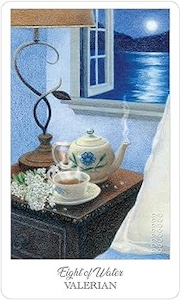
One of the standout features of this deck is its ability to connect the reader with the herbs, forming relationships “for medicine, creativity, ritual, and spiritual guidance.”7 The cards are not just tools for divination; they serve as a bridge to deepen one’s understanding and relationship with plants too. Guthrie’s guidebook provides detailed descriptions of each herb, including its traditional uses, folklore, and ways to integrate it into daily life. This makes the deck an educational resource as well as a spiritual tool, ideal for those who have an interest in herbalism or wish to incorporate nature into their spiritual practice.
In terms of usability, this deck is accessible for both beginners and experienced tarot readers. The imagery is rich and cozy, allowing for intuitive readings based on the set scene, while the guidebook is comprehensive yet easy to follow. The deck encourages a hands-on approach, inviting users to engage with the herbs mentioned, whether through gardening, cooking, or crafting.
Overall, The Herbcrafter’s Tarot is a harmonious blend of art, nature, and spirituality, offering a unique and enriching experience for anyone interested in tarot and herbal wisdom. It has become my go-to tarot deck recently. I absolutely love getting to learn more about the plants themselves, from the practical uses to the spiritual messages they have to share. Guthrie and Colbert have done a wonderful job distilling the essence of each plant into the cards both in the imagery and guidebook for readers to truly connect with their natural powers.
Alanna Kali is an astrologer, numerologist, and pioneer spirit that loves to explore life through the lens of depth psychology. She has a passion for studying the humanities and social trends. Her academic work is centered upon reuniting body, mind, and spirit through eco-psychology. She loves reading, spending time in nature, and travel.
